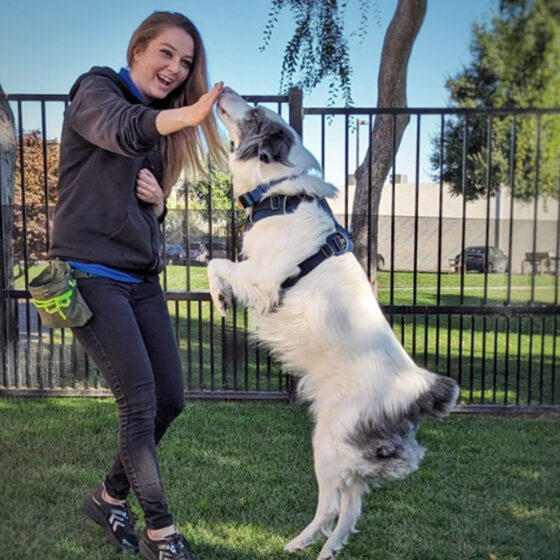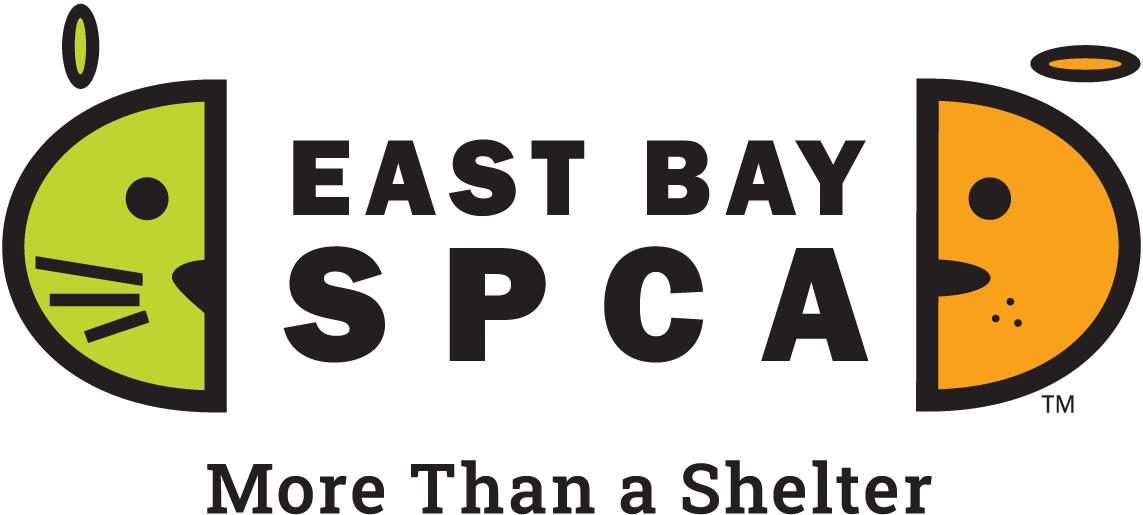Dog Training Classes
Welcome to Canine College

If you are interested in a class that is not currently available, please reach out to us at training@eastbayspca.org to be added to our waitlist. You can also learn more about our private dog training.
Awaiting an opening in our Private Training or Calm, Cool, and Collected class, or want to get a head start on the course material? Our 40-minute “Dog Reactivity Basics” introductory webinar is perfect for you. Available in both English and Spanish for $35.
Our beginner classes are geared towards dogs of all ages that need an introduction to foundational skills. We have classes specializing in puppy socialization and basic manners for dogs of all ages!
Our advanced classes are geared toward those who have previously taken classes and for human-dog teams who are looking to achieve that next level of behavior and training greatness! Read the description to determine if a pre-requesite is necessary for enrollment.
Our specialty classes are designed to be fun, informative, and really take your behavior and training to the next level!
Beginner
Puppy Stars – In-Person
Puppies should be between 8 – 16 weeks old at the start of class.
Bringing out the Einstein in Your Puppy: Start your puppy off right in our cutting edge puppy socialization class. We’ll provide positive exposure to people, dogs, and novel stimuli; help you prepare your pup for grooming, vet care, and other handling; teach you foundation training skills such as relaxation on a mat, sit, recall, leash walking, and targeting; and we’ll focus on puppy-specific topics, such as resource guarding prevention, crate training, potty training, and teething. This class is everything you need to know to raise a puppy!
Prerequisites: None.
Price: $200 for 6 week class ($175 adopter price—if pet was adopted from a non-profit welfare organization)
Freshman Class – In-Person
This is the class to start with if your dog is over 4months old, and you are looking for a strong training foundation! This intro class is designed to build a framework of communication that you can use to teach your dog any behavior. We focus on several key exercises which you can then turn into skills like recall, calm greetings, loose leash walking, and focusing in distracting environments.
Prerequisites:
None! Come with your dog, your treats, and your enthusiasm for training! Note: if your dog barks consistently or uncontrollably at other dogs from within a 10-20ft distance, you may consider taking our Calm Cool and Collected specialty reactivity class, or a private training session before taking Freshman to make sure they have the skills they need to be comfortable and non-disruptive in a group class environment. Not sure about your dog’s needs? Sign up for a free behavior helpline to chat with a trainer about what class fits your dog best!
Price: $200 for 4 week course ($175 for adopted animals)
Sophomore Class – In-Person
In this class you start to take your training to the next level! Once you and your dog have a good grasp of the basics and have had some practice learning in a group environment, we can start pushing the envelope. Want to be able to send your dog to a station and have them wait until released? Want a controlled environment to proof your dog’s new recall cue? Looking for a place to practice heel position past distractions? Sign up for Sophomore!
Prerequisites:
All our East Bay Canine College classes are designed to build directly on one another. If you are signing up for Sophomore class from another organization, we require that you have at least completed our Clicker Training 101 webinar, and that you and your dog be fluent with the following skills:
- Clicker training basics (using your clicker to “mark” then reward the moment your dog performs the desired behavior)
- Nose targeting (+ verbal cue)
- Relaxation on a Mat (as detailed in this handout)
- Stay (+ verbal cue/release cue)
If you feel your dog is not fluent in the above, please sign up for our Freshman class before enrolling in Sophomore.
Price: $200 for 4 week course ($175 for adopted animals)
Advanced
Junior Class – In-Person
This is where we can really start getting fancy! Junior class will help polish up and add levels of difficulty to the skills you already know, while introducing additional behaviors for more complex applications like “cooperative care,” where animals participate in their own husbandry, and prep skills for tests like Canine Good Citizen.
Prerequisites:
All our East Bay Canine College classes are designed to build directly on one another. If you are signing up for Junior class from another organization, we require that you have at least completed our Clicker Training 101 webinar, and be fluent in the following skills:
- Solid clicker training background
- Nose targeting
- Heel position
- Consistent recall
- Paws up
- Go to Mat
- Stay
-
- All behaviors on a verbal cue
If you feel your dog is not fluent in the above, please sign up for an earlier class before enrolling in Junior.
Price: $200 for 4 week class ($175 for adopted animals)
Senior Class – In-Person
Senior class allows you to use the training techniques that you and your dog have perfected to conquer a curriculum of impressive and challenging behaviors! Senior class behaviors can be used to build foundations for things like competition obedience, freestyle, agility, and other advanced certificates such as Canine Good Citizen. And they’re a fun and aerobic way to engage your dog’s mind, and impress your friends!
Prerequisites:
Completion of EBCC Junior class. All our East Bay Canine College classes are designed to build directly on one another. If you are signing up for Senior class, you must have taken at least our Junior class. If you came to our Junior class directly (without having taken Freshman/Sophomore) your instructor will need to sign off on you moving up to senior class. Please note that if you sign up for Senior class without these prerequisites, you will be asked to transfer.
Price: $200 for 4 week class ($175 for adopted animals)
Canine Good Citizen (Prep & Test) – In-Person
For puppies and dogs that are 6 months and older by the first day of class.
Our Canine Good Citizen class is designed to practice the 10 test items you and your dog must pass in order to receive the AKC CGC certificate. The test includes meeting novel people politely, accepting petting and grooming, walking nicely on a loose leash alone and through a crowd, demonstrating Sit, Down, Stay, and Come, meeting another leashed dog, remaining calm during sight and sound distractions and being separated from owner for 3 minutes. On the last day of class, a certified AKC CGC evaluator will conduct the test and determine at that time whether your dog has passed the test.
You and your dog will attend all 5 classes together.
Prerequisites: Completion of our Canine College courses up to Junior level or an equivalent training program.
Price: $225 for the 5 week class ($200 for adopted animals)
Specialty
Calm, Cool, and Collected
Does your dog bark and lunge on walks, from behind gates, or at the windows in your home? Are walks and outings frustrating, embarrassing, or even a little scary? Reactive behaviors are our most commonly requested behavior topic, and our Calm, Cool, and Collected class offers a unique class experience designed with the needs of the dogs in mind.
-
Week 1: Humans only. Goes over the logistics of the class, setup and logistics, several foundation behaviors to learn before week 2, and information gathering so instructors can tailor the class to the individual needs of their students. Also includes management strategies that teams can use to set their dogs up for success in their routine.
-
Week 2: Dogs are on site, but not in the classroom together. Each team rotates through the classroom one at a time (with the others waiting in their cars or with their humans) so that they can explore the space, and practice the skills from week 1 without the pressure of the other dogs present, and get one on one feedback from the instructors. Additional skills are introduced.
-
Week 3: All dogs are present in the classroom, but enter, exit, and practice behind full visual barriers. Options are available at both campuses to set up the visual barrier “pods” outside the classroom if being within earshot is too much that week. Additional skills are introduced, and low-level practice scenarios (instructors as triggers, fake dogs as triggers) are explored as appropriate for each team.
- Week 4: Takes the previous 3 weeks of skills and expands practice scenarios in a controlled environment. This can happen initially at very low levels if needed, such as using fake dogs, or recordings before offering visual contact.
-
Weeks 5 and 6 are continuations of week 4, and are tailored specifically to the individual needs and comfort levels of the class. These exercises can involve outdoor parallel walks, “trigger chasing” in obstacle courses, and focus on handlers learning which practical exercises and skills are relevant for what types of “real world” situations. Week 6 offers a comprehensive overview of how teams can design a sustainable training plan utilizing their new skills.
Price: $250 for 6 week class ($225 for adopted animals)
Awaiting an opening in our Private Training or Calm, Cool, and Collected class, or want to get a head start on the course material?
Our 40-minute “Dog Reactivity Basics” introductory webinar is perfect for you, and is designed to offer a preview of what you will learn in week 1 of CCC class. Available in both English and Spanish for $35.
Intro to Nosework
For dogs that are 6 months and older by the first day of class.
Nosework is an easy to learn activity that uses a dog’s natural abilities for hunting to find hidden treats, toys or other items. This game builds confidence and focus as the dog is rewarded for doing what comes naturally! It’s also a safe way to provide mental and physical exercise to all types of dogs. Handlers will learn about dog body language and how to motivate your dog, which are great tools for developing your relationship with your pet!
Prerequisites: None.
Behavioral Appropriateness: Dogs work one at a time so this is a great class for dogs that are not comfortable around other dogs. Dogs must be crate trained and able to handle confinement in a crate between turns.
Price: $200 for 6 week class ($175 for adopted animals)
Nose Work 2: Introducing Odor
For dogs that are 6 months and older by the first day of class.
Introducing Odor is a continuation of skills from our Intro to Nose Work Class. Dogs are taught to identify the target odors: Anise, Birch, and Clove. Skills that each handler will acquire from the class include search techniques, dog/handler teamwork and reading the dog’s body language during the search.
Prerequisites: Dogs and handlers must have completed Intro to Nose Work and have instructor approval to register for this class.
Behavioral Appropriateness: Dogs work one at a time so this is a great class for dogs that are not comfortable around other dogs. Dogs must be crate trained and able to handle confinement in a crate between turns.
Price: $200 for 6 week class ($175 for adopted animals)
Scholarship Program
We have a scholarship program to offer financial assistance with helplines, private trainings, and group classes. Scholarships are available for both feline and canine training. If you are interested in applying for financial assistance with a behavior program, please fill out our Scholarship Application.

